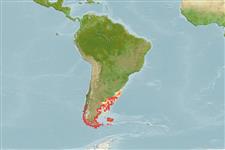Environment: milieu / climate zone / depth range / distribution range
Ökologie
seewasser benthopelagisch; tiefenbereich 0 - 250 m (Ref. 127764). Temperate; 32°S - 57°S, 76°W - 53°W
Southeast Pacific and Southwest Atlantic: Valparaíso, Chile and Patagonian region of Argentina to Tierra del Fuego.
Size / Gewicht / Alter
Maturity: Lm ? range ? - ? cm
Max length : 90.0 cm TL (female); max. veröff. Gewicht: 0.00 g
Rückenflossenstacheln (insgesamt): 7 - 8; Rückenflossenweichstrahlen (insgesamt): 23-27; Afterflossenstacheln 0; Afterflossenweichstrahlen: 0. Caudal fin emarginate. Body blue brown dorsally and silvery yellow ventrally. First and second dorsal fins grayish, caudal fin brownish, their distal parts yellowish. Anal fin pale brown (Ref. 27363).
Life cycle and mating behavior
Geschlechtsreife | Fortpflanzung | Ablaichen | Eier | Fecundity | Larven
Corporacion de Fomento de la Produccion (Chile), 1980. Catálogo de recursos pesqueros Chile. Instituto de Fomento Pesquero, Gerencia de Desarollo, CORFO, Santiago, Chile. (Ref. 5964)
IUCN Rote Liste Status (Ref. 130435)
Bedrohung für Menschen
Harmless
Nutzung durch Menschen
Fischereien: weniger kommerziell
Mehr Information
NamenSynonymeMetabolismusRäuberÖkotoxikologieFortpflanzungGeschlechtsreifeAblaichenSpawning aggregationFecundityEierEientwicklung
Tools
Zusatzinformationen
Download XML
Internet Quellen
Estimates based on models
Preferred temperature (Ref.
123201): 7 - 16.1, mean 10.7 °C (based on 172 cells).
Phylogenetic diversity index (Ref.
82804): PD
50 = 1.5000 [Uniqueness, from 0.5 = low to 2.0 = high].
Bayesian length-weight: a=0.00977 (0.00428 - 0.02232), b=3.06 (2.85 - 3.27), in cm total length, based on LWR estimates for this (Sub)family-body shape (Ref.
93245).
Trophic level (Ref.
69278): 3.5 ±0.41 se; based on food items.
Generation time: 15.7 ( na - na) years. Estimated as median ln(3)/K based on 2
growth studies.
Widerstandsfähigkeit (Ref.
120179): mittel, Verdopplung der Population dauert 1,4 - 4,4 Jahre. (Assuming tm <4).
Fishing Vulnerability (Ref.
59153): Very high vulnerability (76 of 100).
Climate Vulnerability (Ref.
125649): Very high vulnerability (100 of 100).
Nutrients (Ref.
124155): Calcium = 15.3 [9.6, 26.5] mg/100g; Iron = 0.224 [0.142, 0.358] mg/100g; Protein = 17.9 [17.1, 18.8] %; Omega3 = 0.517 [0.296, 0.895] g/100g; Selenium = 18.6 [9.9, 36.3] μg/100g; VitaminA = 17.4 [5.3, 57.2] μg/100g; Zinc = 0.557 [0.408, 0.774] mg/100g (wet weight);
